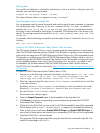The counters are:
• Read Hit Req/s—The number of read requests per second completed from the array cache
memory. Data may reside in the cache memory due to a previous cache miss or because of
a prefetch operation generated by a sequential read data stream.
• Read Hit MB/s—The rate at which data is read from the array cache memory because of
read hit requests.
• Read Hit Latency—The average time it takes to complete a read request (from initiation
to information receipt) from the array cache memory.
• Read Miss Req/s—The number of read requests (per second) that failed to complete from
the array cache memory and were completed from physical disks instead.
• Read Miss Data Rate—The rate at which data is read from physical disks because the
data was not present in the array cache memory.
• Read Miss Latency—The average time it takes to complete a read request (from initiation
to information receipt) from the physical disks.
• Write Req/s—The number of write requests per second completed to a virtual disk that
were received from all hosts. Write requests may include transfers from a source array to this
array for data replication and host data written to snapshot or snapclone volumes.
• Write Data Rate—The rate at which data is written to the virtual disk by all hosts and
includes transfers from the source array to the destination array.
• Write Latency—This average time it takes to complete a write request (from initiation to
receipt of write completion).
• Flush MB/s—The rate at which data is written to physical storage. Data replication data
written to the destination volume is included in the flush statistics. Host writes to snapshot and
snapclone volumes are included in the flush statistics. However, data flow for internal snapshot
and snapclone normalization and copy-before-write activity is not included.
• Mirror MB/s—The rate at which data moves across the mirror port in servicing read and
write requests to a virtual disk. Write data is always copied through the mirror port when
cache mirroring is enabled for redundancy. The mirror data rate includes read data from the
owning controller that must be returned to the requesting host through the proxy controller.
Reported mirror traffic is always outbound from the referenced controller to the other controller.
• Prefetch MB/s—The rate at which data is read from physical storage into cache in
anticipation of subsequent reads when a sequential read stream is detected. Data replication
initial copy data traffic for a replicated virtual disk is reported by the owning controller in the
source volume prefetch statistics.
• Redundancy—This displays the virtual disk RAID level.
• Number of presentations—This displays the number of hosts that the virtual disk has
been presented to.
• Preferred path—This displays the path that is preferred for the I/O communication.
HP EVA virtual disk group
The virtual disk group object provides the aggregate virtual disk statistics on a disk group basis.
The counters are:
• Total Read Hit Req/s—The total number of read requests per second completed from
the array cache memory. Data can reside in the cache memory due to a previous cache miss
or because of a prefetch operation generated by a sequential read data stream.
• Total Read Hit MB/s—The total rate at which data is read from the array cache memory
because of read hit requests.
Using the graphical user interface 89


















